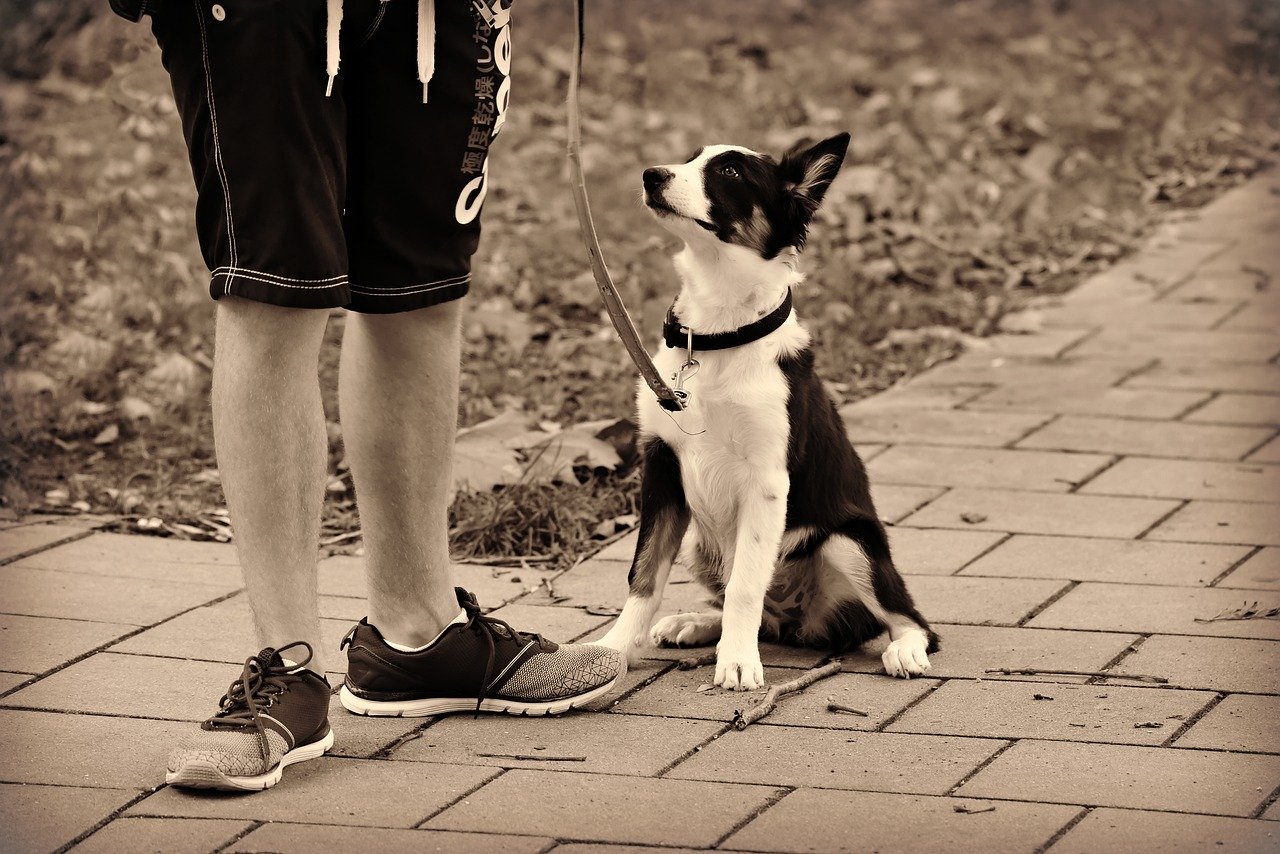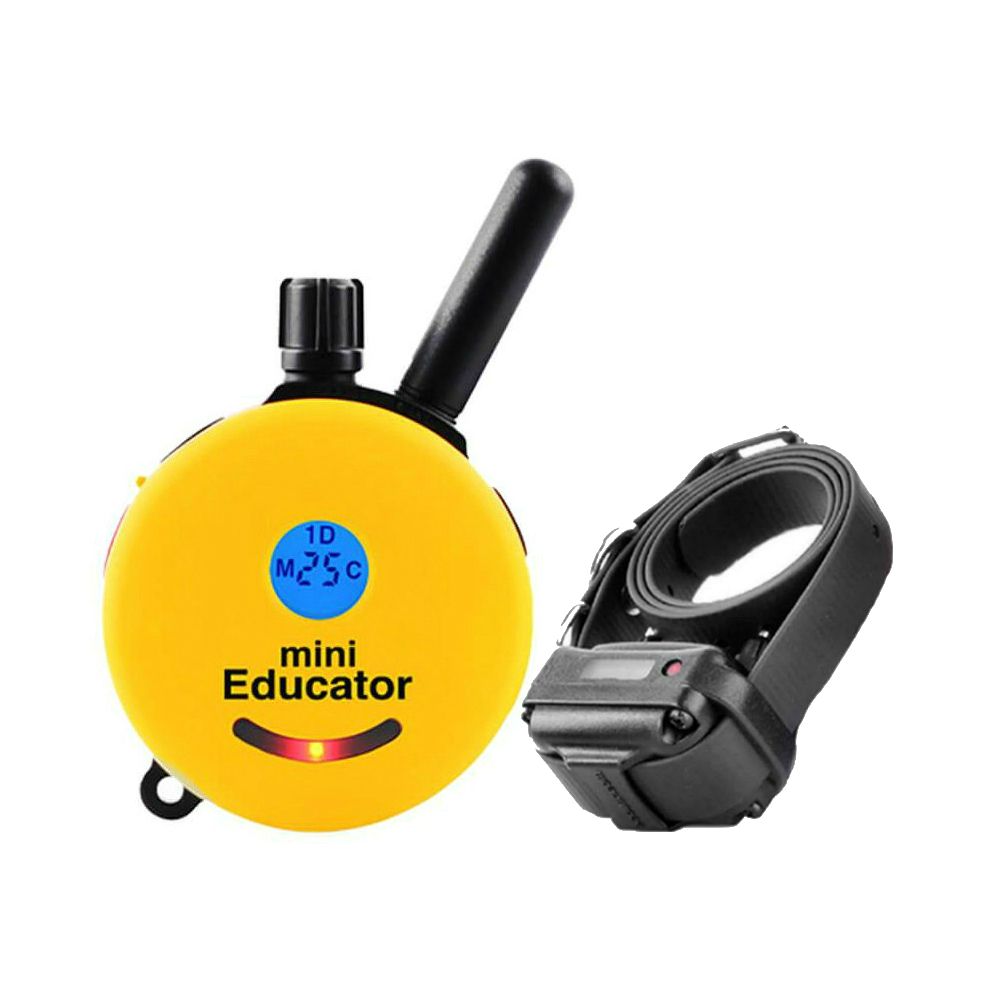In this article we will cover the “Heel” command. Again, we will be starting with teaching the verbal command and then move to reinforcing this command using the eCollar …
Teach the “Heel” Command without an E Collar
You should have developed a routine with your dog by now. You can call your dog to you and have him sit. He has learned to “Stay” when commanded, and you have begun working around distractions and in new locations.
Both you and your pet understand how training works and look forward to the sessions. You should both be having fun and building rapport. Take a moment to recognize how much you both have learned in your first few weeks of training.
Congratulations!
When training your dog to heal you will introduce your dog to a brand new concept by asking him to maintain a relative position to you. Whether you are standing, walking, running or riding a bike, your dog will remain at your side.
He should not be charging ahead of you or tugging at the lead; he should not be lagging behind you sniffing at what he pleases, but at your side and following your lead.
The most important part of teaching your dog to heel is getting him to maintain his attention on you. For this reason, it’s best to work on this command in short (5 – 10 minutes), frequent, intense sessions.
Stay mindful that you don’t work your dog beyond his ability to focus. It’s better to cut a session short then confuse or overtax your dog.
Heeling is a very challenging lesson and, more than any other, will require your patience, consistency and persistence. But you don’t need a dog trainer you can teach your dog yourself with a few training sessions.
Lesson One: Establishing the Heel Zone
Start with your dog standing at your left side. He should be wearing his flat collar and a six-foot lead as well as the e-collar. Imagine a four to five foot circle around you. This will be his initial heel zone.

Get your dog’s attention by saying his name or touching his head.
When he looks at you, begin walking quickly forward stepping off with your left foot. He should begin moving with you but, if he doesn’t, don’t stop.
Simply continue walking and allow the lead to do its job. When he is back within the four-foot circle make sure the lead is slack and praise him.
If he begins to move ahead of you, turn 180 degrees and keep walking. Allow the lead to snap a correction if he doesn’t follow immediately. This will get his attention.
Continue in a straight line, remembering to allow the lead to go slack when he’s within the heel zone. You want him to learn that when he is at your side the pressure on the lead stops.
Continue turning 180 and later 90 degrees each time he forges ahead until he is watching you closely.
REVIEW:
• With your dog at your side, get his attention.
• When he looks at you, begin briskly walking forward.
• If he lags, let the lead correct him; do not stop moving forward.
• If he forges ahead, quickly turn 180 degrees, allowing the lead to correct him.
• When he’s within the heel zone, let the lead go slack and praise him.
• Keep the lessons short and frequent.
What if…
If your dog doesn’t stay attentive to you when you use his name, use a bit of bait such as a treat or toy to gain and hold his attention.
Once you have his attention begin walking briskly forward. He should follow you closely in anticipation of the reward. This is especially useful with puppies that are easily distracted.
Take care not to over-use the bait and only reward when he performs as asked. Phase out the reward once your dog demonstrates that he understands the command.
Lesson Two: Adding the command
When your dog is walking at your near side for at least ten steps with his attention on you, you will add the command, “Heel.” Get your dog’s attention then slap your left hip, command “Heel” and begin walking.
Correct with a leash snap when he moves out of the heel zone. When he is paying attention and keeping at your side, begin changing direction randomly. This will confuse him at first, but he will learn to watch you to keep track of where you are.
It may take many sessions before your dog starts staying within the heel zone without correction or your dog may find it fun to follow your lead right away and you can get your dog to heel quickly.
REVIEW:
• With your dog at your side, get his attention.
• When he looks at you, slap your hip, command “Heel,” and walk forward.
• Praise him when he is within the heel zone, making sure the lead is slack.
• Change directions to keep him engaged.
• Give your dog many repetitions to assure he understands.

Teach the “Heel” Command with an E Collar
Your dog should understand that when you command “Heel,” he is to stay at your side wherever you go. Thus far, you have been using a Positive Aversion technique to teach your dog to heel by adding a leash correction to let your dog know when he is outside of the heel position.
Now you will apply the Negative Aversion technique and replace the leash correction with the e-collar stimulation. Initially, you corrected your dog the moment he stopped heeling and moved out of the heel zone.
You will now apply Negative Aversion to teach your dog to heel by removing stimulation when your dog complies. If you have been following the program outlined here, your dog should be familiar with the e-collar and should understand what the sensation means. He should have learned that to stop the sensation he must do as commanded.
If you have not been following the program, go back to the Introduction to Electronic Collars section and follow the steps outlined there before proceeding.
Lesson One: Establishing the Heel Zone
For this lesson you will begin with your dog standing at your side. He will be wearing his flat collar and leash as well as the e-collar. Hold the lead in your right hand with a treat in your left hand.
You are going to reduce the heel zone to a two- to three-foot circle. Command, “Heel” and begin walking forward. If your dog is doing a good job of staying next to you, change directions quickly and, as the leash tightens, tap the remote and command “Heel” again.
Take care that you begin tapping precisely when the lead is tight and not when your dog is moving toward you. Continue tapping until he’s in position then stop tapping and praise/reward.
Repeat this routine in many locations until he is maintaining the heel position for longer periods. If he strays only a little from the zone use a leash correction only.
REVIEW:
• Stepping with your left foot forward, command “Heel.”|
• Change directions when he drifts outside of the heel zone, which is now two to three feet.
• When the leash tightens begin tapping the remote.
• Stop tapping when your dog is within the heel zone.
• Praise/reward with a treat when he is walking at your side, within the heel zone.
• Correct with only the leash for small errors.
Lesson Two: Heeling Off Lead
Once your dog is staying in the heel position for extended periods of time, even when you change directions or speed, you’re ready to phase out the lead.
It’s important that you practice this in a safe, fenced area with your dog wearing his flat collar, lead and e-collar. Let the leash drag.
Get his attention, and command “Heel,” as you walk forward.
If he drifts out of the proper position, change directions and begin tapping the remote until he is at your side. Be sure to end the lesson on a positive note and engage in some fun activity.
REVIEW:
• With your dog at your side, let his leash drag or drape over his back.
• Command “Heel” and start walking forward, left foot first.
• When your dog drifts out of the heel zone tap the remote.
• When he is in the heel position stop tapping.
• Praise your dog when he heels properly.
Lesson Three: Distractions
When your dog is heeling consistently without the lead in a secured area, you can begin working with distractions. You may want to enlist an assistant to introduce the distractions.
Keep your dog’s flat collar and lead on at first. If your dog bolts for a distraction you can step on the lead to correct him. Also be prepared to increase the stimulation level when distractions are present.
Do not lose your temper or allow yourself to become frustrated. Your dog needs many repetitions to become conditioned to respond as you wish instead of acting on instinct. This can be a slow process for some dogs. Be attentive to your pal, taking care not to overwork him.
Lesson Four: Adding the Automatic Sit
Now that your dog will heel both on- and off-leash, you should command him to “Sit” when you stop walking. Every time you stop, command, “Sit” and reinforce with e-collar stimulation and even physically placing him in the sit position if necessary.
Since your dog already knows the “Sit” command, he should catch on quickly. Many dogs can learn the automatic sit in one session.
What if…
If your dog is leaning on you or heeling so closely that he impedes your movement, you may be correcting him with the trainer when he is too close. Relax the size of the circle and only correct when he drifts too far. You may also incorporate more left turns and changes in speed to keep him on his toes and following your movement.
If your dog seems to be confused by the e-collar corrections, return to leash training for at least a full week. Reintroduce the remote trainer when he is proficient at complying to the command.
If your dog ignores the electronic collar corrections you may need to increase the level of intensity until you find the level that gets his attention.
If your dog lags all the time he is probably bored. Heeling is not fun for most dogs. Remember to keep the lessons short and intersperse with play and other commands that he has mastered.




Subscribeto get the latest dog training articles, latest offers & news.
You have Successfully Subscribed!